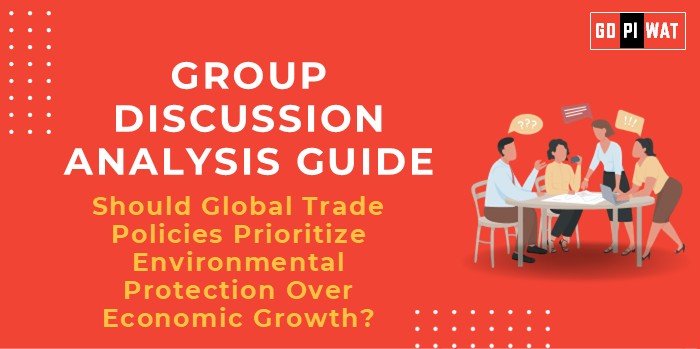📋 Group Discussion Analysis Guide
🌍 Should Global Trade Policies Prioritize Environmental Protection Over Economic Growth?
📝 Introduction to the Topic
🌐 Opening Context
In an era marked by climate change and economic inequality, the debate over whether global trade policies should prioritize environmental sustainability over economic expansion remains contentious.
📜 Background
Historically, trade policies aimed at maximizing economic growth, leading to significant environmental degradation. Recent international efforts like the Paris Agreement and UN Sustainable Development Goals (SDGs) have emphasized the importance of aligning trade with environmental goals.
📊 Quick Facts and Key Statistics
- 🌎 Global Emissions: Trade accounts for 30% of global CO2 emissions.
- 💸 Economic Impact of Green Policies: Adopting green trade policies could cost up to 2% of global GDP by 2030 but avert climate damages worth trillions.
- 🌍 International Agreements: Over 150 countries have committed to net-zero carbon targets, impacting trade decisions.
🤝 Stakeholders and Their Roles
- 🏛️ Governments: Regulate trade policies and negotiate international agreements.
- 🏢 Private Sector: Innovate and implement eco-friendly production practices.
- 🌐 International Organizations: Ensure compliance with environmental norms.
- 👥 Consumers: Drive demand for sustainable goods.
🏆 Achievements and Challenges
✨ Achievements
- ✅ The European Union’s Green Deal requires carbon-neutral goods by 2050, setting global benchmarks.
- ✅ Increased trade in renewable energy technologies like solar panels.
⚠️ Challenges
- ❌ Economic disparities hinder equitable policy adoption across developing nations.
- ❌ The conflict between short-term economic goals and long-term environmental benefits.
🌍 Global Comparisons
- 🇩🇪 Success: Germany transitioned to green trade with minimal GDP impact.
- 🌍 Challenges: Developing nations face trade-offs between exports and sustainability due to cost-intensive green technologies.
💡 Structured Arguments for Discussion
- ✅ Supporting Stance: “Environmental degradation from trade threatens global sustainability. Policies must prioritize the planet.”
- 🛑 Opposing Stance: “Economic growth ensures funds for future green investments. Prioritizing it is pragmatic.”
- ⚖️ Balanced Perspective: “A phased approach balancing economic and environmental goals ensures sustainable progress.”
🎯 Effective Discussion Approaches
- 📊 Opening Approaches:
- “The trade-off between sustainability and economic growth defines today’s global challenges.”
- “With trade driving 30% of CO2 emissions, ignoring environmental impacts is perilous.”
- ⚡ Counter-Argument Handling:
- Use case studies like Germany’s green policies to showcase feasibility.
- Cite economic resilience of countries adopting green technologies.
🧠 Strategic Analysis of Strengths and Weaknesses
- 💪 Strengths: Increased green job creation, long-term environmental benefits.
- 🛠️ Weaknesses: High upfront costs and resistance from industry.
- 🌟 Opportunities: Green trade leadership and new markets for sustainable goods.
- ⚠️ Threats: Economic disruptions and non-compliance by major emitters.
🏫 Connecting with B-School Applications
📚 Real-World Applications
- Projects on sustainable supply chain management or carbon trading.
🎓 Sample Interview Questions
- ❓ “What role do businesses play in balancing trade and sustainability?”
- ❓ “Can economic growth coexist with strict environmental policies?”
📘 Insights for Students
- 💡 Explore ESG (Environmental, Social, Governance) investing and green logistics strategies.


